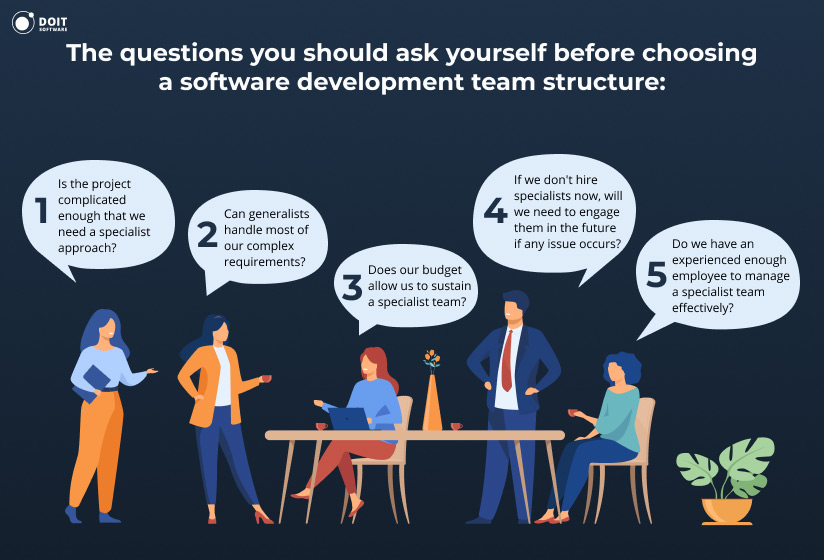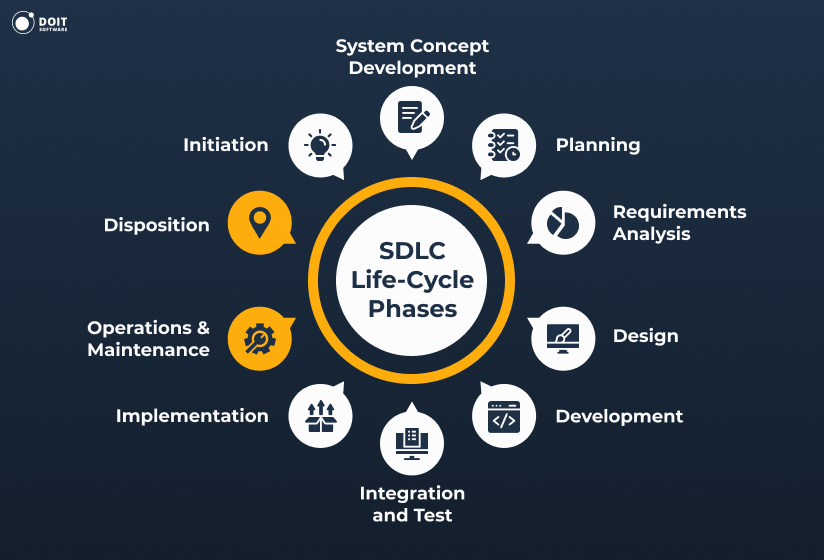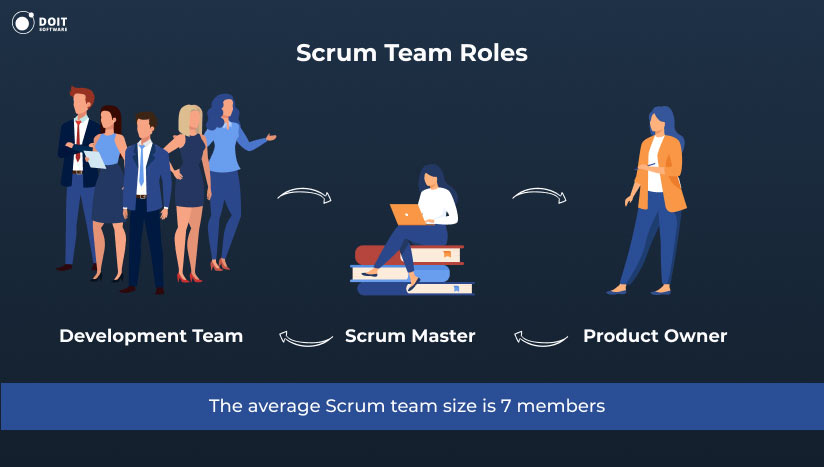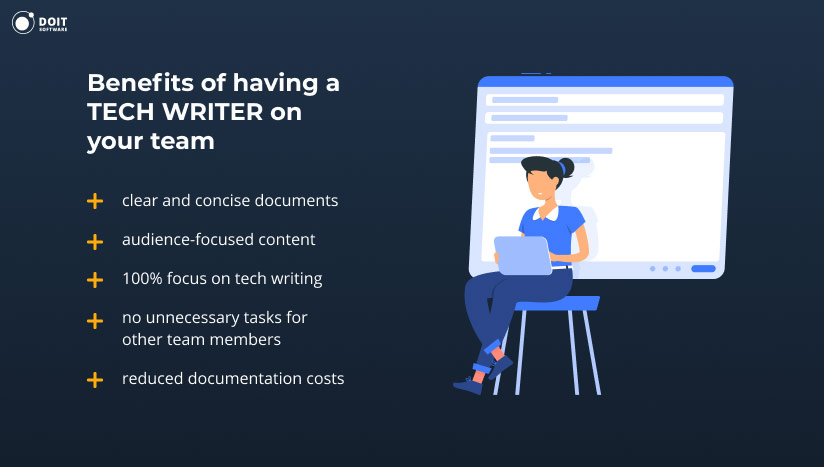For companies preparing to launch an ambitious project, finding a qualified software development team is a necessity. No matter if their stack is not enough to carry out the complicated task, or whether they have no in-house team at all, they should be ready for this challenging task – candidate search.
In order to do it right, business owners should learn IT terminology, the industry best practices, and common performance markers. “How do I hire the right team” is the first question to answer before the actual hiring process begins.
We believe that our expertise can help you find the answer and make your development team search process much faster and easier. So if you are a business owner aiming at building a product, here’s some useful information for you about what an agile software development team is, how it is different from a traditional one, its composition, member roles, and much more.
On top of that, we’ll cover some techniques to estimate a given team’s prowess when it comes to a particular project.
There are many debates about software development team skill sets on the web. It’s no wonder that you can have a little doubt about whom you should hire first: a specialist, a generalist, or both?
What matters in reality is not the breadth or depth of a particular professional’s skills, but their adaptability and open-mindedness. Suppose a person has no problem with learning and self-development – and a true professional does not – in that case they will be able to switch from generalist to specialist role on-demand with relative ease.
Another important criterion is soft skills. According to Forbes, soft skills are becoming more and more important, regardless of the industry, and this trend will only continue to increase in the future.
One more important thing – Agile Manifesto states that individuals and interactions stand above processes and tools. What does this mean? Sometimes it is better to have someone in the team who writes plain working code on the team than someone who writes super-efficient yet obscure code, thus causing data siloing and miscommunication.
Of course, a client is looking for a full skill set within a single software development team. The learning time is simply not part of their project. So which type of team to pick? Let’s take a closer look.
Generalist team members have an understanding of how the product works as a whole and how to improve it, if needed
Lacking both experience and theoretical knowledge, generalists sometimes fail to use a particular technology most efficiently
Good at multitasking, learning new technologies, and adaptation
Compared head to head against a specialist, take more time to finish a task
Focus on communication and work across silos
Rely on “executive presence” in decision-making
Becoming a generalist is merely a natural point in every developer’s career, should they choose to become Team Leads or Project Managers, master a new tool or a related technology. It is not unheard of that PMs write code, fix bugs, and fill the gaps in product documentation in their available.
Check out our article “Remote teams vs On-site teams vs Distributed teams. Which one to choose for your project?”
It is also not unheard of that developers write and run tests for their own software or deliver turnkey solutions single-handedly, from product design and interface to business logic and basic analytics. These professionals pretty much fall into the definition of a generalist.
Look for a generalist team if you need a simple, single-purpose product. In some cases, this team can even consist of one person.
Each specialist has profound knowledge of their domain
Face the risk of data siloing and miscommunication
Specialist team can finish fairly complex projects faster
May need more time to fit the separate project components together
Master the project details
Rely on good project management
When it comes to complex scalable solutions, a generalist team will just lack the required knowledge to cope with their implementation. For example, a product owner has an idea to develop a healthcare-related website that must be equally convenient to access from all mainstream platforms, feature custom corporate website design, and analyze visitor data.
It takes the following web development team roles: Front-end, Backend, UI/UX Design, and Data Analyst. Besides, the website must be multilingual, so someone must take over professional copywriting and translations (ideally, with proper SEO). How about proper licensing and personal data protection legal compliance?

For a generalist team, finishing the project would take much more time and result in overall lower quality of the product.
Offer a healthy balance of specialization and cross-technology knowledge
Assembling a perfect hybrid team might turn out expensive and time-consuming
Potentially the best composition that leads to maximum efficiency
Require precise distribution of responsibilities
The obvious conclusion of this section is to rely on the stakeholders’ vision of the project and their needs when it comes to choosing a team type. Each project is unique, so the number of parameters to take into consideration is considerable. Both specialist-only and generalist-only teams have weaknesses that make them unsuitable in certain scenarios. The hybrid team is the best of two worlds.
In fact, the default scrum team structure assumes the existence of both specialists and generalists by default: a PM or a Team Lead is the software development team’s chief generalist, while each development team department is dedicated to their specific task.
A software development project management expert ties all the team together and removes all the miscommunication issues. You will see them literally run back and forth between departments all day, doing their job and delivering the holistic image of the project to the client.
That also brings us to the discussion of the difference between traditional and agile teams.
First thing to say is that agile and traditional teams rely on fundamentally different approaches. Let’s look at the most distinctive disparities between the two:
Organizational structure
Iterative, Continuous Integration/Delivery
Linear, Software Development Life Cycle (SDLC)Iterative, Continuous Integration/Delivery
User requirements
Interactive input
Clearly defined before implementationInteractive input
Involvement of clients
Throughout a project development
Only the early stages of a project
Documentation
Less important than the project’s constant evolution thus rather unreliable
Written once, maximally detailed and unambiguous
Time estimation
Extremely approximated, done by the team, short-term planning
Maximally precise, done by the PM, long-term planning
Get inspired by our article “Custom software development costs: how to estimate your budget”
The traditional waterfall model was documented in 1970, twenty years before the appearance of Scrum, Agile Manifesto, in turn, appeared in 2001, more than 10 years after Scrum showed up.
Hence, it is important to mention that Scrum should not be confused with Agile. One can still follow Agile methodology without Scrum boards, sprints, and daily meet-ups.
The waterfall model was being abandoned because following it in software development proved inappropriate.
A fairly complex solution takes half a year and more to develop. Client requirements, user expectations, and the market situation in a given niche are guaranteed to change during that period. Agile approach is designed to satisfy the need for change whenever it arises instead of avoiding it and moving on.
Some may find the way agile software development teams estimate task effort lighthearted: who would associate task effort with T-shirt or dog sizes? Nonetheless, it is the way to reflect the fact that effort and time are impossible to predict beforehand more precisely.
These facts shouldn’t give the impression that the traditional approach is hopelessly outdated and inefficient. Choose it if:
It turns out that the domains where the waterfall model best proves its value deal with material objects: hardware development and the construction industry, for example. It perfectly correlates with the fact that back in times when the waterfall model was developed, software could not have been imagined as separate from hardware and having its own value.
Some authors use the term “Software Development Life Cycle” for any methodology in general. According to that vision, the agile methodology would have its own SDLC that is different from the one used in the waterfall model.
The others associate SDLC exclusively with the waterfall model, which we will do within the scope of this article.
As we already mentioned, Software Development Life Cycle is linear in the waterfall model. It means that on any given stage of development, a product-in-progress can either subsequently receive a “Go” or a “No Go” status that would transition it to the next stage or back to the beginning of the current one correspondingly.

Here is a brief overview of SDLC roles and responsibilities:
Traditional SDLC features a rigid vertical structure or organization. Developers mind that “Project Manager knows best,” and a PM, in their turn, relies on the approval of Chief Officers.
One of the intentions behind Scrum and Agile methodologies was to eliminate the drawbacks of the traditional model (which was better fitted to design hardware). Excessive documentation, redundant approvals, and reviews slowed the actual development, while the lack of user feedback turned the development process into blind guessing rather than resolution of real user problems. Therefore, the core values of Scrum were defined: Transparency, Inspection, and Adaptability.
The structure of a Scrum team is:
Developer Team can have as many specific roles as necessary. The detailed description of these agile development roles is as follows.

When a PO does not have enough knowledge in the domain of application of a software product, it makes sense to bring in a Subject Matter Expert (SME). SME is like an expert user of a potential product-in-the-making. Sometimes POs don’t have enough time to write user stories and supply the software development team with an optimal workload.
Similarly to a SME, a Business Analyst (BA) does not exactly belong to the Developer Team, so what is their role? Neither SME nor BA fit into the three base roles of Scrum. The attitude to them is usually biased: either their role and duties should be taken up by POs or PMs, evenly distributed among developers, or given to a dedicated professional (or department) only after serious consideration.
However, on an optimistic note,when a software development team does feel a lack of clarity as to what a product would look like (when there are multiple stakeholders with different conflicting goals and visions, for example), a lack of open communication, a lack of understanding what potential users expect of a product, or just anything else that neither of the base roles can provide, then a Business Analyst might be a silver bullet to these problems, and the chances to cover all the clients’ and end users’ needs will rise.
Some teams that do not explicitly identify as agile are perfectly fine with putting a BA as a proxy between the dev team and the client business.
The Team Lead role causes a lot of confusion, too. In Scrum teams, a Scrum Master is de facto leading the software development team. So, from the structural point of view, they are the Team Lead and occupy a PM position. On the other hand, every particular development department (such as Backend, Frontend, Design) has a Team Lead of their own.
Depending on a project’s area of application and scale, methodology, and software development team size, a Software Developer Team Lead role is identical to an Architect (which why these two roles are mentioned interchangeably on the job listings). The latter is sometimes referred to as Tech Lead.
Now, while the definition of the Team Lead role is quite broad, Architects specialize in technology. They define the relations of software components, coding conventions, tools, and platforms. You’d typically find them leading backend or full-stack teams, or a development organization as a whole, like a CTO in the traditional model would.
UI/UX Designer is a magician who makes everything users see and interact with appealing and convenient. Not every software development team member must be an engineer. A Product designer is an artist.
If Frontend developers work on the positioning of interface elements, Designers work on their custom look and impression.
Full-Stack Developers carry out the actual software development tasks, tying together the application interface and its business logic. Before the emergence of advanced graphic interfaces, there simply was not that much to do with the application interface – “that’s frontend, that’s it”. Design tools were integrated into a development environment (such as in the case of Delphi). Even now IDEs ship with design tools that enable developers to link interface components with application functions immediately. The examples of this are MS Visual Studio or Qt.
Nonetheless, building adaptive cross-platform app interfaces requires some extra expertise (e.g. Qt Markup Language knowledge in the Qt environment). There is still a big gap between interface building skills (frontend) and the functionality behind it (backend) in the domain of web development, which is why there are the respective separate roles to handle the former and the latter.
Backend developers work on the server side of a website. Specifically, user query processing, all resource-intensive calculations, communication with other apps (or websites, or devices), and more – everything that makes an end product act as a single (organism or unit)
How do you provide service to a million users in a minute? Facebook deals with 4 times more than that. How do you secure a billion dollar money transfer online? Which user data storage is convenient to apply Data Mining to? Backenders know the answers to these and many other critical questions for the project’s success.
The responsibilities of a backend developer include making a product modular. The system of their design will be easy to upgrade. If one of its components needs replacement, redesigning the whole system will not be necessary. If the number of users significantly increases, it will be ready to scale and so on.
In agile software development teams, backenders may actively suggest the solutions they deem optimal, leaving the final decision to a product owner, of course.
But none of that would matter if the product doesn’t look good or have an intuitive interface, because, after all, the product is intended for its users.
Frontend developers build all the application interface elements that a user interacts with. A cross-platform PC application or a web-based one must adapt to every screen size and resolution that displays it. Not only that; it also must be lightweight to run smoothly on the lower-end devices. This is what frontenders take care of. It is obvious that since console applications have become largely deprecated (at least for an average user), their role became as much important as backenders’.
By the way, modern frontenders deal with interactive animated 3D elements and scripted events, which requires them to write executable code on a daily basis.
Quality Assurance (QA) Engineers take care of polishing the end product, generally speaking. Developers cannot imagine all the possible states that their application can be in. They can’t imagine how an app can be misused because they focus entirely on how it can be used to solve a given problem.
The QA team makes sure that the users can safely try to misuse the product without breaking it or suffering any kind of damage themselves. Additionally, QAs test an app or website’s accessibility.
Software developer responsibilities sometimes do include writing tests, as a part of the Test-Driven Development technique, but even then the role of QA is not removed nor its importance diminished.
Besides, the QA department backs up developers by writing tests and product documentation, implementing suggestions on the improvement of the product, and helping to observe the best development practices.
QA Engineers are the editors of code writing. In practice, writers rarely risk working without them.
Automated and Manual testing both have their place depending on a test subject. User-friendliness, for example, can not be tested automatically. As for the other system parameters, automating every repeatable test that can be automated is merely a reasonable move. It will cut down on time, human effort, and money spent in the long run. Hence, there is a Quality Assurance Automation(QAA) Engineer role.
The DevOps role does not originate from the agile methodology, and the DevOps approach has some distinct differences from it. If Agile/Scrum stands for transparency so that everyone knows what everyone else is doing, DevOps enables data siloing between software development teams and acts as a single central body that manages automation, cooperation, and communication to a reasonable degree.
They make sure that in situations when different developer teams work on different components:
It is evident that the composition of each given team depends on the software development tasks at hand. The list of agile team roles given above is not complete. Whenever the need in a less common role arises (it could be a psychologist, no jokes here), the team management should consider hiring a respective new team member instead of risking the fate of their project.
Another role that is not often mentioned in the guidebooks is Tech Writer. In the good old days, developers used to write all the documentation themselves (and not included in the code to be seen by the collaborating developers). This practice is not entirely gone nowadays.
A comprehensive and logically structured product documentation requires time and focus. If a project scope allows developers to use their spare time on writing it – good, there is nothing inappropriate about that. The fact is, developers would rather write code and solve problems, so the documentation-writing gig goes off to Tech Writers. This position entails knowing corresponding standards (like Microsoft Style Guide) and tools (Confluence being the most simplistic), not to mention the general SW development competence, code-reading, and communication skills.

Some companies assign their QA engineers to do it, yet some others let the whole software development team contribute whatever they can.
So far, we can safely conclude that:
Installable PC software is also referred to as “standalone.” It works on Linux, Mac, or Windows, serving a single user as a rule. A suite of office programs is an example of such software.
Modern infotainment system software that is used, for example, in self-driving cars is also considered and developed as standalone. This domain of development is not going to die out anytime soon.
A minimal build software development team could include:

PC development has been here since time immemorial, so there are plenty of legacy tools. VS Code and Qt; less often, IntelliJ or Eclipse. The languages used are C#, Objective C, Python, C/C++, and the niche-specific ones like R. Any additional scripting language can be used.
Web-based applications deliver services to thousands of users at the same time. Users like them because such apps do not heavily rely on the computational power of their devices, do not take up much space to store the necessary data, and work as long as the internet connection is up.
It is easy to compare a standalone office program package with Google Docs Suite. The latter is web-based. It saves user’s data to the cloud almost instantly. There is no need to physically carry the storage devices around; it is also quite hard to ever lose data, just keep your login safe.
Two members are enough for the minimal build:
Either of the two can share the role of a PM. Simple!
A serious project would involve more people and more roles so that a product could be deployed faster, error-free, and ready for scaling and extension with third-party applications.
On top of that, to make a product convenient to use from mobile devices, a Mobile App Development department would come in handy. A Chatbot developer would provide an inexpensive way to support users without hiring a whole Customer Support team.
Software development team professionals use an Integrated Development Environment of their choice; it is typically lightweight and functional VS Code. Frontend technologies: HTML5, CSS, JavaScript. Backend: NodeJS or possibly, Python for various purposes like Data Mining, or chatbots.
Embedded software development engineers work closer to hardware than any other team on the list. The hardware in question has unique restrictions due to its miniature size. Environment sensors, visual recognition, autonomous vehicles, everything that belongs to the Internet-of-Things – these domains are their bread and butter. Look for such teams if you’re setting up a smart house. Or a military base!
Embedded software engineering team roles most often exclude Designers or Frontenders. The software made by embedded engineers is meant to communicate with particular hardware and other machines, not humans.
Thus, a single embedded developer is a software development team of its own.
As a products’ complexity rises, more developers will collaborate on it under the guidance of an experienced Architect and other typical agile team members. A QA team and a Business Analyst will be required as well.
Any mainstream IDE fits their purpose. If the solution is relatively simple, any text editor will suffice: Notepad++ or Editpad are good examples. To test their code, embedded developers run appropriate emulators and debuggers (like Valgrind). For the most part, the code is written in pure C or C++, in conjunction withscripting languages like Python.
The success of Uber is a good point to prove why mobile applications are important. You’ll see people toying around with their smartphones all the time: they enjoy dating apps, countless casual games, media players, task managers, or anything else that caught their attention on the AppStore or Google Play. Why not if these apps are so easy to download and use on the go?
Mobile devices offer huge marketing possibilities. Their traffic, conversion rate, total usage time – all these indicators keep slowly rising in numbers as of late 2020.

Anyway, mobile application development team roles will correspond to a chosen methodology. The developers and Quality Assurance pros will be the core of the team or make up a separate department depending on whether the application is a part of a bigger project or not.
Each of the two mobile device operating systems (iOS and Android) has its own native programming language. iOS native apps are written in Objective C and Swift. Android apps are typically written in Java or Kotlin. When Windows Phones were still around, they used C# and Visual Basic applications.
It is technically possible to develop both Android and iOS apps on, say, React Native or Flutter, as a part of cross-platform mobile development.
A mobile device display parameters and unique hardware architecture make it difficult for developers who previously specialized on desktop development to carry their skills over. That said, a great mobile app development team cannot consist predominantly of generalists, although a BA would be, without a doubt, incredibly helpful in particular cases.
A sufficiently complex product would require all the roles in software development we have listed.
For the sake of example, think about something extremely common: a food catering business.
It is impossible to imagine any business without a website. In our particular case, a website will:
Website backend developers will set up user accounts and the ordering workflow. Frontend developers can make sure that the website is perfectly usable from any device. So does this company need both a website and an app? Yes, it does. To put it succinctly, an app would help the company stay closer to its users.
There’s a good reason to install self-service kiosks at stores as soon as possible. The programming for these is carried out by Full-Stack engineers or by Embedded developers in conjunction with Frontenders. The technologies used in the development are going to be entirely different from those used in web development.
Quality Assurance is indispensable in such projects: they will detect problems before the whole project is staged for release.
Finally, it takes a Data Analyst to process all the data aggregated from the website, the app, and the terminals, and turn it into a set of potentially beneficial business decisions to better serve their audience by improving the products and optimizing sales. A Business Analyst or a Subject Matter Expert will look for potential markets and research the niche.
Depending on the chosen approach and goals, the other roles can be involved.
Check out our article “Top Big Data Technologies in 2024: How They Can Benefit Your Business”
The traditional way of building a long-standing business is to start hiring in-house developers one by one, starting with a highly experienced Senior professional (because it takes an expert to hire an expert) and moving on as needed. The right people will stay, while those who turned out incapable of carrying out the tasks or otherwise unable to fit in with the team will leave.
It certainly will require a lot more time than hiring an independent team of software developers to design and maintain a system of the client’s choice. Start-ups usually do not have the luxury of time nor a dedicated HR department to accelerate the process.
To help you decide which software development team to hire, the in-house or the remote one, let us narrow down the choice of countries with the best software developers in the world.
These rankings are not absolute. Statistical data tends to be inaccurate and biased. The criteria taken into consideration wildly vary across researchers, so we have reviewed them and come up with the following list of the top 4 best countries to outsource software development in 2024:

The other countries with huge outsourcing potential are South Korea, The Philippines, Hungary, Romania, Bulgaria, Egypt, Mexico, Brazil, Russia, Taiwan, and Vietnam. Due to the lack of experience, language and cultural gaps, unfavorable political climate, or legislation differences, these countries are somewhat less ideal for outsourcing complex projects.
So if you don’t happen to be a resident of one of the top countries for outsourcing, chances are that project prices will seem extremely low. The possible time zone difference will be worth the great opportunity to cooperate with the best engineers, instantly hiring a perfect software development team to deliver a fast, high-quality solution.
Unless a client wants to follow a scientific guideline on performance evaluation of software development teams, there are a few simple steps to determine their fitness.
Hopefully, this article will be a valuable guide if you’re having a hard time hiring your first software development team. Now you know some basic terminology, software development team structure types, software development team processes, methodologies, and technologies depending on the platform focus.
We also mentioned some benefits of software development outsourcing. Such as, there is no need to allocate physical space for a remote team, and, truth be told, such a team often delivers an exceptional quality solution with a lower price tag attached to it.
One more thing we can share is the showcase of our custom solutions. Our software development team has provable experience in Web Development, Mobile App Development, and unique solutions according to client’s requirements. If you want to build a software project from scratch or are looking for a way to upgrade an existing one – get in touch!
Methodologies the branch of philosophy that analyzes the principles and procedures of inquiry in a particular discipline More (Definitions, Synonyms, Translation).
DOIT Software covers full-cycle product development. Share your requirements to receive a quote.
Contact usSoftware development team members are all specialists involved in the development process. Product Owner contributes to planning, financing, and product evaluation; Project manager ensures the communication between the dev team and the client side. The software developer team that works on the product may include Frontend, Backend, QA engineers, DevOps, Tech Writing, BA, and other specialists.
Building a software development team may start when a product owner has decided on a development approach (agile or traditional) and the final product’s look and purpose. A detailed, unambiguous product description is obligatory in the case of SDLC application. The team composition will depend on the end product’s desired functionality, budget, and time restrictions.
Managing software development teams is undoubtedly the most stressful and responsible role in a team, especially within a traditional management approach. For that reason, there are guides, standards, and institutions that provide respective education to both SDLC and agile project managers.
Considering the variety of possible project scopes, there is no upper limit to the number of team members. “Optimal Development Team size is small enough to remain nimble and large enough to complete significant work within a Sprint,” as stated in the Scrum Guide.
It is best to have 5 to 9 people within agile software development teams. Product Owner, Project Manager, and Lead Developer are obligatory, and other roles depend on the project’s target platform.
The Project manager is the key figure in traditional software development teams. The impact of clients is limited to the starting phases of a product’s life cycle. As for the agile teams, there really is no central figure because every team member can suggest changes to a product and shares its ownership with other members.










